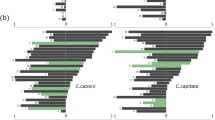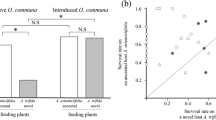Abstract
In holometabolous phytophagous insects, adult females and larvae determine host plant selection through oviposition and feeding preferences. Pre-imaginal and/or imaginal experiences with plant chemical cues can modulate these preferences. Various studies found evidence, or not, of host preference modulation through previous experience but they appear to contradict each other. Most probably, modulation of host preference depends on the degree of specialization of the insects. Our literature analysis revealed that the positive influence of experience in the modulation of host plant preference occurred equally in polyphagous, oligophagous and monophagous species, but was significantly more influenced by the phylogeny of the insect and the developmental stage involved in plant cue experience. Identification of phylogenic and developmental stage factors of “host learning” abilities appeared to be key information for predicting the response of species to habitat modifications rather than the insect’s degree of host plant specialization. The signification of this output on the fact that some insect species or populations shifted from the wild to cultivated habitats to become important pests is discussed.


Similar content being viewed by others
References
Agosta SJ (2006) On ecological fitting, plant-insect associations, herbivore host shifts, and host plant selection. Oikos 114:556–565
Anderson P, Anton S (2014) Experience-based modulation of behavioural responses to plant volatiles and other sensory cues in insect herbivores. Plant, Cell Environ 37:1826–1835
Atkinson PR (1980) On the biology, distribution and natural host-plants of Eldana saccharina Walker (Lepidoptera: Pyralidae). J Entomol Soc South Afr 43:171–194
Barron AB (2001) The life and death of Hopkins’ host-selection principle. J Insect Behav 14:725–737
Bell WJ (1990) Searching behavior patterns in insects. Annu Rev Entomol 35:447–467
Berdegué M, Trumble JT (1996) Effects of plant chemical extracts and physical characteristics of Apium graveolens and Chenopodium murale on host choice by Spodoptera exigua larvae. Entomol Exp Appl 78:253–262
Bernays EA (2001) Neural limitations in phytophagous insects: implications for diet breadth and evolution of host affiliation. Annu Rev Entomol 46:703–727
Bernays EA, Chapman RF (1994) Host-plant selection by phytophagous insects. Chapman & Hall, New York
Blackiston DJ, Casey ES, Weiss MR (2008) Retention of memory through metamorphosis: Can a moth remember what it learned as a caterpillar? PLoS ONE 3(3):e1736. doi:10.1371/journal.pone.0001736
Brown JM, Abrahamson WG, Packer RA, Way PA (1995) The role of natural-enemy escape in a gallmaker host-plant shift. Oecologia 104:52–60
Bush GL (1969) Sympatric host race formation and speciation in frugivorous flies of the genus Rhagoletis (Diptera, Tephritidae). Evolution 23:237–251
Carrasco D, Larsson MC, Anderson P (2015) Insect host plant selection in complex environments. Curr Opin Insect Sci 8:1–7
Corbet SA (1985) Insect chemosensory responses: a chemical legacy hypothesis. Ecol Entomol 10:143–153
Cunningham JP, Zalucki MP, West SA (1999) Learning in Helicoverpa armigera (Lepidoptera: Noctuidae): a new look at the behaviour and control of a polyphagous pest. Bull Entomol Res 89:201–207
Davis JM, Stamps JA (2004) The effect of natal experience on habitat preferences. Trends Ecol Evol 19:411–416
Delobel A (1995) The shift of Caryedon serratus Ol. from wild Caesalpiniaceae to groundnuts took place in West Africa (Coleoptera: Bruchidae). J Stored Prod Res 31:101–102
Dukas R (2008) Evolutionary biology of insect learning. Annu Rev Entomol 53:145–160
Hadfield JD, Nakagawa S (2010) General quantitative genetic methods for comparative biology: phylogenies, taxonomies and multi-trait models for continuous and categorical characters. J Evol Biol 23:494–508
Hopkins AD (1916) Economic investigations of the scolytid bark and timber beetles of North America. US Department of Agriculture Program of Work, Washington DC
Izzo VM, Mercer N, Armstrong J, Chen YH (2014) Variation in host usage among geographic populations of Leptinotarsa decemlineata, the Colorado potato beetle. J Pest Sci 87:597–608
Jaenike J (1983) Induction of host preference in Drosophila melanogaster. Oecologia 58:320–325
Jaenike J (1988) Effects of early adult experience on host selection in insects: some experimental and theoretical results. J Insect Behav 1:3–15
Jahner JP, Bonilla MB, Badik KJ, Shapiro AM, Forister LM (2011) Use of exotic hosts by Lepidoptera: widespread species colonize more novel hosts. Evolution 65:2719–2724
Kfir R, Overholt WA, Khan ZR, Polaszek A (2002) Biology and management of economically important lepidopteran cereal stem borers in Africa. Annu Rev Entomol 47:701–731
Lanfear R, Calcott B, Ho SYW, Guindon S (2012) PartitionFinder: combined selection of partitioning schemes and substitution models for phylogenetic analyses. Mol Biol Evol 29:1695–1701
Le Ru B, Capdevielle-Dulac C, Conlong D, Pallangyo B, Van Den Berg J, Ong’amo G, Kergoat GJ (2015) A revision of the genus Conicofrontia Hampson (Lepidoptera, Noctuidae, Apameini, Sesamiina), with description of a new species: new insights from morphological, ecological and molecular data. Zootaxa 3925:56–74
Löhr B (2001) Diamondback moth on peas, really. Biocontrol News Inf 19:38N–39N
Papaj DR, Prokopy RJ (1989) Ecological and evolutionary aspects of learning in phytophagous insects. Annu Rev Entomol 34:315–350
Paradis E (2013) Molecular dating of phylogenies by likelihood methods: a comparison of models and a new information criterion. Mol Phylogenet Evol 67:436–444
Pentzold S, Zagrobelny M, Rook F, Bak S (2014) How insects overcome two-component plant chemical defence: plant ß-glucosidases as the main target for herbivore adaptation. Biol Rev Camb Philos Soc 89:531–551
Petit C, Le Ru B, Dupas S, Frérot B, Ahuya P, Kaiser-Arnauld L, Harry M, Calatayud P-A (2015) Influence of dietary experience on the induction of preference of adult moths and larvae for a new olfactory cue. PLoS ONE 10(8):e0136169
Ronquist F, Huelsenbeck JP (2003) MrBayes 3: Bayesian phylogenetic inference under mixed models. Bioinformatics 19:1572–1574
Rossiter MC (1987) Genetic and phenotypic variation in diet breadth in a generalist herbivore. Evol Ecol 1:272–282
Schoonhoven LM, van Loon JJA, Dicke M (2005) Insect-plant biology. Oxford University Press, New York
Tabashnik BE (1983) Host range evolution: the shift from native legume hosts to alfalfa by the butterfly, Colias philodice eriphyle. Evolution 37:150–162
Thiéry D, Moreau J (2013) Induction natale de la préférence pour l’habitat (NHPI). In: Sauvion N, Calatayud P-A, Thiéry D, Marion-Poll F (eds) Interactions insectes-plantes. Quae & IRD, Paris, pp 383–389
Thorpe WH, Jones FGW (1937) Olfactory conditioning in a parasitic insect and its relation to the problem of host selection. Proc R Soc Lond B 124:56–81
Tissot M, Stocker RF (2000) Metamorphosis in Drosophila and other insects: the fate of neurons throughout the stages. Prog Neurobiol 62:89–111
Via S (1999) Reproductive isolation between sympatric races of pea aphids. I. Gene flow restriction and habitat choice. Evolution 53:1446–1457
Villemereuil P, Nakagawa S (2014) General quantitative genetic method for comparative biology. In: Garamszegi ZL (ed) Modern phylogenetic comparative methods and their application in evolutionary biology: concepts and practice. Springer, Heidelberg, pp 287–303
Walsh BD (1864) On phytophagic varieties and phytophagic species. Proc Entomol Soc Phila 3:403–430
Wiklund C (1975) The evolutionary relationship between adult oviposition preferences and larval host plant range in Papilio machaon L. Oecologia 18:185–197
Acknowledgements
We thank the French Ministry of Foreign Affairs, IRD (Institut de Recherche pour le Développement) and icipe (Nairobi, Kenya) for their financial supports. Thanks are also given to Fritz Schulthess for his review of the manuscript and the anonymous reviewers for their useful recommendations.
Author information
Authors and Affiliations
Corresponding author
Ethics declarations
Conflict of interest
Authors Christophe Petit, Stéphane Dupas, Denis Thiéry, Claire Capdevielle-Dulac, Bruno Le Ru, Myriam Harry and Paul-André Calatayud declare that they have no conflict of interest.
Ethical approval
This article does not contain any studies with human participants or animals performed by any of the authors.
Additional information
Communicated by N. Desneux.
Electronic supplementary material
Below is the link to the electronic supplementary material.
Rights and permissions
About this article
Cite this article
Petit, C., Dupas, S., Thiéry, D. et al. Do the mechanisms modulating host preference in holometabolous phytophagous insects depend on their host plant specialization? A quantitative literature analysis. J Pest Sci 90, 797–805 (2017). https://doi.org/10.1007/s10340-017-0833-4
Received:
Revised:
Accepted:
Published:
Issue Date:
DOI: https://doi.org/10.1007/s10340-017-0833-4




